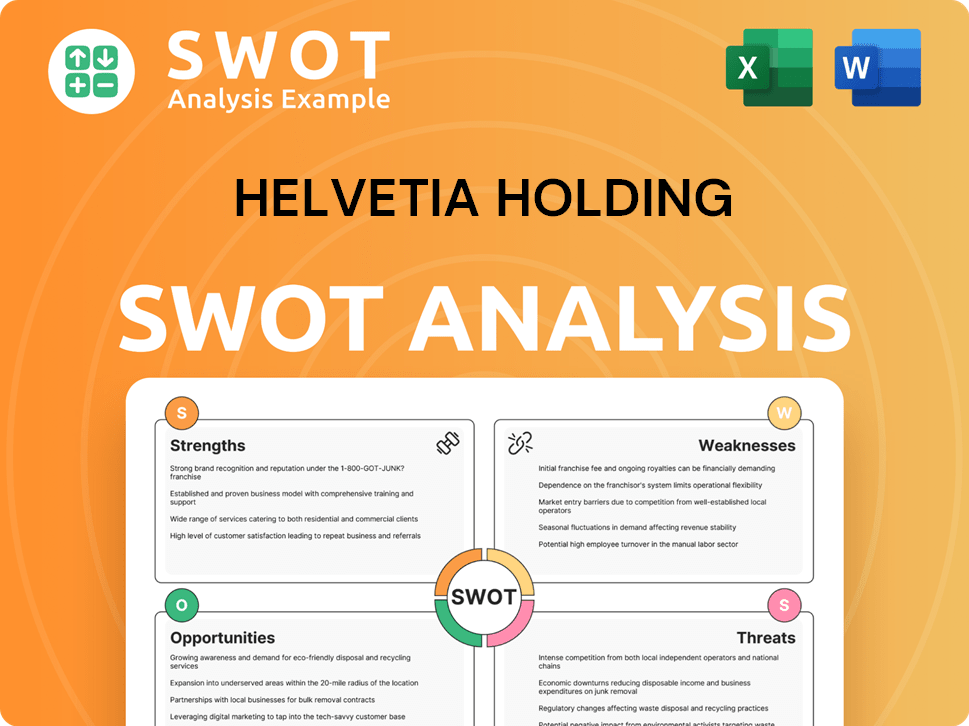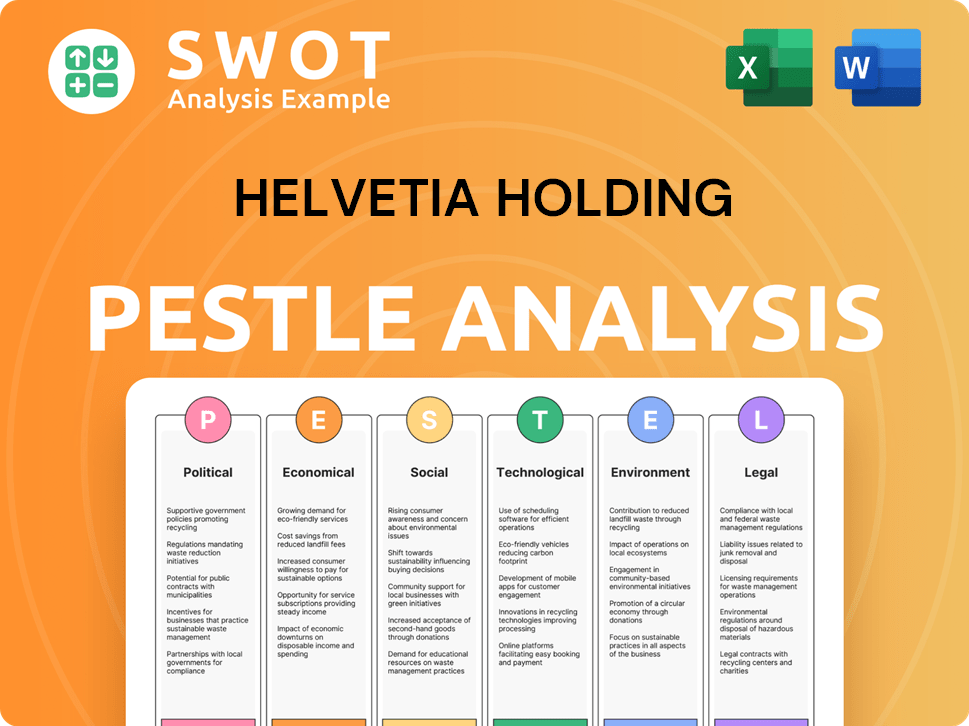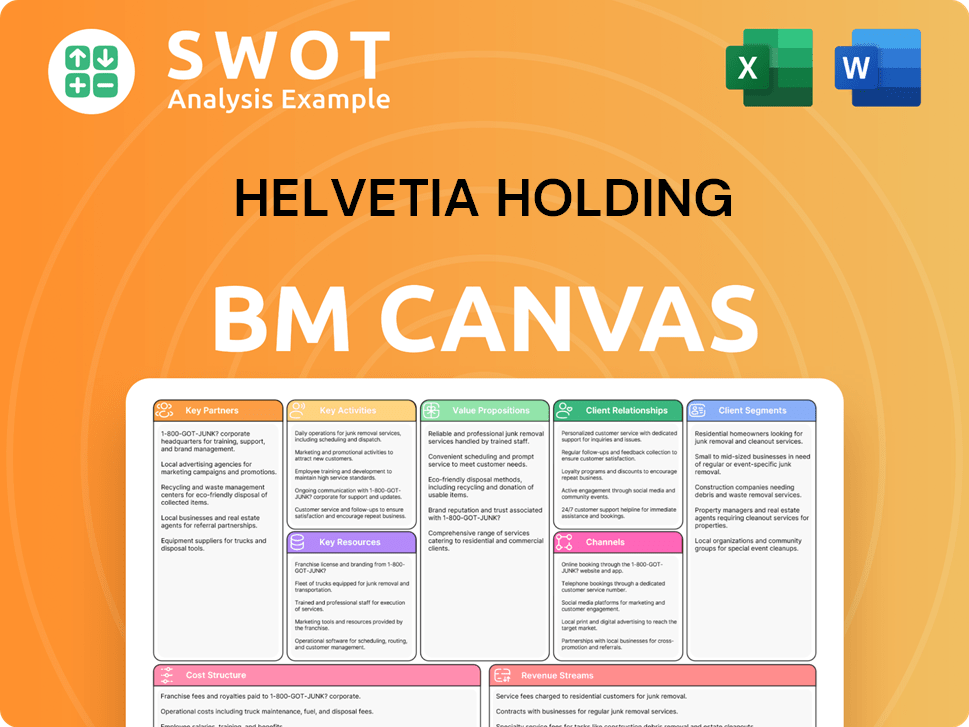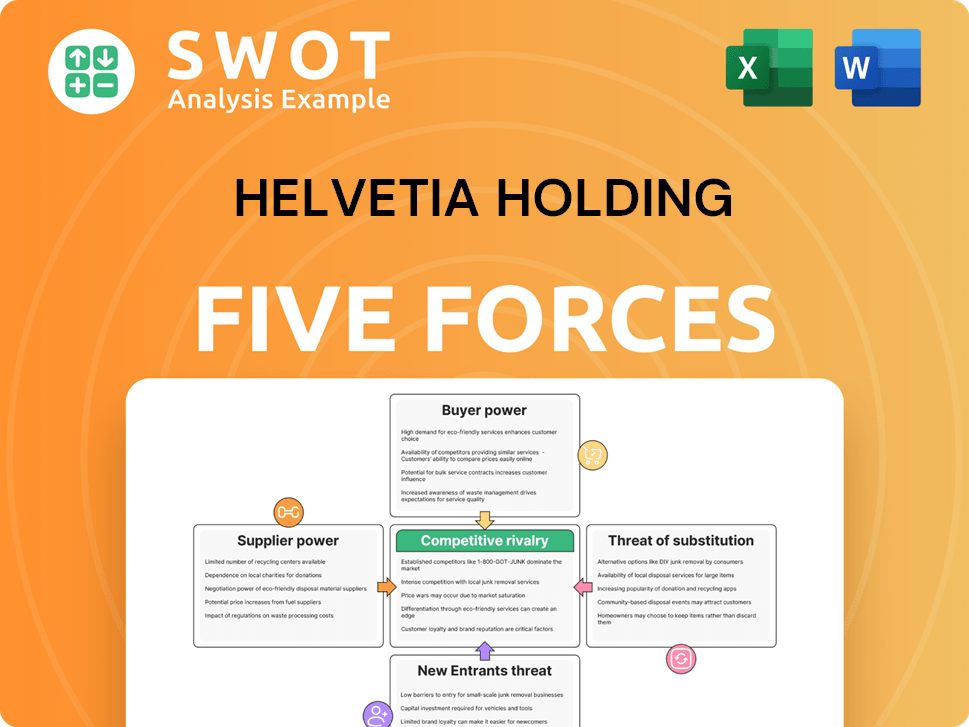Helvetia Holding Bundle
How has Helvetia Holding Company transformed its sales and marketing approach?
Explore the evolution of Helvetia Holding Company's sales and marketing strategies, a key driver of its success in the competitive insurance market. From its origins in 1858 to its current omnichannel approach, Helvetia has consistently adapted to meet the changing needs of its customers. The 'Helvetia 20.25' strategy, in particular, marked a significant shift towards digitalization and customer-centricity within the Swiss insurance landscape.

This analysis dives deep into Helvetia Holding Company's Helvetia Holding SWOT Analysis, revealing its sales strategy, marketing strategy, and how it navigates the financial services sector. We'll examine the specific marketing tactics employed by Helvetia, its brand positioning, and the campaigns that have boosted its market share. Understanding Helvetia's approach provides valuable insights for anyone interested in the insurance market and best practices for insurance sales teams.
How Does Helvetia Holding Reach Its Customers?
The sales strategy of Helvetia Holding Company centers on a diversified approach, blending traditional and digital sales channels to reach a broad customer base. This sales strategy is designed to optimize channel performance, enhance customer experience, and drive efficiency across all touchpoints. The company's approach reflects a strategic shift towards greater digital adoption, aiming to increase the share of digitally acquired customers.
Helvetia leverages a mix of offline and online channels. Offline channels include a robust network of exclusive agents and brokers, crucial for complex insurance products requiring personalized advice. Online channels include the company website, offering direct sales capabilities and comprehensive information. This omnichannel approach allows customers to seamlessly move between online and offline channels.
In 2023, Helvetia reported a strong agency force, particularly in Switzerland and Germany, which significantly contributed to new business acquisition. The company also uses partnerships, such as collaborations with financial advisors, to expand its reach and tap into new customer segments. These strategic shifts are designed to optimize channel performance, with a clear emphasis on enhancing customer experience and driving efficiency across all touchpoints.
Helvetia's primary offline sales channels include a network of exclusive agents and brokers. These agents are pivotal for selling complex insurance products that require personalized advice. This channel is particularly important for relationship building and servicing specific client segments.
The company website serves as a vital online channel, offering direct sales capabilities for simpler insurance products. Helvetia has invested in digital platforms to enhance customer self-service and direct interaction. The focus is on seamless omnichannel integration, allowing customers to move between online and offline channels effortlessly.
Helvetia leverages partnerships, such as collaborations with financial advisors and other distribution partners. These partnerships help expand its reach and tap into new customer segments. This strategy is designed to optimize channel performance and enhance customer experience.
Helvetia's 'Helvetia 20.25' strategy accelerated digital integration to increase the share of digitally acquired customers. The company is focused on enhancing customer self-service and direct interaction through digital platforms. This reflects a strategic shift towards greater digital adoption.
Helvetia's sales strategy involves a balanced approach, combining traditional and digital channels to reach a wide customer base. This strategy aims to enhance customer experience and drive efficiency. The company focuses on digital transformation and strategic partnerships to optimize channel performance.
- Strong agency force, particularly in Switzerland and Germany, contributing significantly to new business acquisition.
- Emphasis on digital platforms to enhance customer self-service and direct interaction.
- Strategic partnerships to expand reach and tap into new customer segments.
- Focus on seamless omnichannel integration for a better customer experience.
Helvetia Holding SWOT Analysis
- Complete SWOT Breakdown
- Fully Customizable
- Editable in Excel & Word
- Professional Formatting
- Investor-Ready Format

What Marketing Tactics Does Helvetia Holding Use?
The marketing tactics employed by the company are designed to build brand awareness, generate leads, and drive sales in the insurance and financial services sectors. The approach integrates both digital and traditional marketing strategies to reach a broad audience. This comprehensive strategy is crucial for maintaining a strong presence in the competitive insurance market.
Digital marketing efforts include content marketing, search engine optimization (SEO), paid advertising, and email marketing. Traditional methods involve print advertisements and selective media spots. This blend ensures that the company can effectively target its core markets and adapt to evolving customer preferences.
The company's marketing strategy emphasizes data-driven decision-making and customer-centricity, particularly through the 'Helvetia 20.25' strategy. This focus on digital transformation and customer journey optimization reflects a commitment to modern marketing practices and enhancing customer experience.
Content marketing is a key component, with educational articles and guides distributed via the website and social media. SEO is used to improve online visibility, ensuring services are easily found by potential customers. Paid advertising, including SEM and display ads, targets specific demographics.
Email marketing campaigns are used for lead nurturing, customer retention, and promoting new products, often personalized based on customer segmentation. Social media platforms like LinkedIn and Facebook are used for brand engagement and customer service. This helps in fostering direct communication with customers.
Traditional marketing includes print advertisements in financial publications and selective TV and radio spots. These campaigns primarily target core markets such as Switzerland, Germany, Spain, and Austria. This strategy helps maintain brand recognition.
The company leverages customer data for segmentation and personalization to tailor product offerings and communication. Analytics tools are crucial for tracking campaign performance, optimizing marketing spend, and understanding customer behavior. This approach enhances the effectiveness of marketing efforts.
The 'Helvetia 20.25' strategy prioritizes digital transformation and customer-centricity, leading to more integrated and agile marketing operations. This focus is designed to improve efficiency and customer satisfaction. This strategic shift is crucial for adapting to the evolving market landscape.
The company focuses on innovative digital solutions and customer journey optimization to enhance the overall customer experience. This includes improving online platforms and streamlining interactions. This commitment helps in building stronger customer relationships.
The company's marketing strategy is multifaceted, integrating digital and traditional approaches to maximize reach and effectiveness. This approach is designed to enhance its sales strategy and overall performance in the Owners & Shareholders of Helvetia Holding.
- Digital Marketing: Content marketing, SEO, SEM, display ads, and email marketing.
- Traditional Marketing: Print ads, TV, and radio spots in core markets.
- Data Analytics: Leveraging customer data for segmentation and personalization.
- Customer-Centricity: Focus on innovative digital solutions and customer journey optimization.
- Strategic Framework: The 'Helvetia 20.25' strategy drives digital transformation and agile marketing.
Helvetia Holding PESTLE Analysis
- Covers All 6 PESTLE Categories
- No Research Needed – Save Hours of Work
- Built by Experts, Trusted by Consultants
- Instant Download, Ready to Use
- 100% Editable, Fully Customizable

How Is Helvetia Holding Positioned in the Market?
The brand positioning of Helvetia Holding Company centers on reliability, innovation, and customer-centricity within the insurance market and financial services sectors. This approach aims to differentiate the company through its comprehensive offerings and strong regional presence. The core message revolves around providing security and peace of mind, empowering clients to confidently manage their financial futures.
Helvetia's visual identity often incorporates elements of stability and trustworthiness, while its tone of voice is professional yet approachable. This strategy supports building long-term relationships with clients. The customer experience is designed to offer personalized service, expert advice, and efficient claims processing, reflecting a commitment to quality and customer satisfaction.
Helvetia strategically targets its audience by blending traditional values with modern solutions, especially emphasizing innovation in product development and digital services. This is evident in its focus on 'ecosystems' like 'Home' and 'Mobility,' providing integrated solutions beyond traditional insurance. This approach helps Helvetia to stay competitive in the dynamic financial services landscape.
Helvetia emphasizes core values such as reliability, innovation, and customer-centricity to build trust and long-term relationships. These values are consistently communicated across all channels, ensuring a cohesive brand experience. This consistency is crucial for maintaining a strong brand reputation in the competitive Swiss insurance market.
The company targets individuals and businesses seeking quality, reliability, and comprehensive coverage. Helvetia's marketing strategies are tailored to resonate with these segments, focusing on their specific needs and preferences. This targeted approach helps in effective customer acquisition and retention within the financial services sector.
Helvetia differentiates itself through its comprehensive offerings and a strong regional presence, particularly in Switzerland. The focus on integrated solutions, like ecosystems for 'Home' and 'Mobility,' sets it apart from competitors. This strategic positioning helps Helvetia maintain a competitive edge in the insurance market.
Sustainability is an increasingly important aspect of Helvetia's brand appeal, reflecting growing consumer interest in socially responsible businesses. This commitment enhances brand perception and aligns with the values of a broader customer base. This focus on sustainability is a key element in Helvetia's marketing strategy.
Helvetia's brand consistency is maintained across all channels, from agents and brokers to digital platforms, ensuring a cohesive customer journey. The company actively monitors shifts in consumer sentiment and competitive threats, adapting its brand messaging and offerings to remain relevant and competitive. For more details on how Helvetia operates, consider reading about the Revenue Streams & Business Model of Helvetia Holding.
Helvetia Holding Business Model Canvas
- Complete 9-Block Business Model Canvas
- Effortlessly Communicate Your Business Strategy
- Investor-Ready BMC Format
- 100% Editable and Customizable
- Clear and Structured Layout

What Are Helvetia Holding’s Most Notable Campaigns?
The Sales strategy and Marketing strategy of Helvetia Holding Company involve several key campaigns designed to enhance its market position within the Insurance market and broader Financial services sector. These campaigns, especially under the 'Helvetia 20.25' strategy, focus on expanding beyond traditional insurance offerings to provide comprehensive solutions. The company's efforts are also heavily invested in digitalization and improving customer experience, reflecting a forward-thinking approach to Swiss insurance.
A significant ongoing initiative is the 'ecosystems' strategy, particularly in the 'Home' and 'Mobility' sectors. This aims to offer integrated services beyond insurance, addressing broader customer needs. For instance, the 'Home' ecosystem includes services related to home security and smart home technology. These campaigns are supported by digital platforms, content marketing, and partnerships. In 2023, Helvetia reported a substantial increase in business volume, reaching CHF 11,308.2 million, indicating the success of these strategic initiatives.
Helvetia also focuses on enhancing customer experience through digitalization. This includes simplifying customer interactions and offering seamless omnichannel experiences. These efforts are supported by digital advertising, email marketing, and improvements to the company's website and mobile applications. These initiatives aim to improve customer satisfaction and increase digital engagement. The company consistently highlights its financial strength and stability in its brand communications, reinforcing its position as a reliable and forward-thinking insurance group.
The 'ecosystems' strategy focuses on integrated services in 'Home' and 'Mobility.' The goal is to offer comprehensive solutions beyond traditional insurance, such as home security and smart home technology. This approach aims to position Helvetia as a partner in daily life, using digital platforms and partnerships to reach customers.
Helvetia invests in digitalization to simplify customer interactions and enhance digital self-service options. This includes digital advertising, email marketing, and improvements to the website and mobile apps. The focus is on creating a seamless omnichannel experience to increase customer satisfaction and engagement.
Helvetia Holding Porter's Five Forces Analysis
- Covers All 5 Competitive Forces in Detail
- Structured for Consultants, Students, and Founders
- 100% Editable in Microsoft Word & Excel
- Instant Digital Download – Use Immediately
- Compatible with Mac & PC – Fully Unlocked

Related Blogs
- What are Mission Vision & Core Values of Helvetia Holding Company?
- What is Competitive Landscape of Helvetia Holding Company?
- What is Growth Strategy and Future Prospects of Helvetia Holding Company?
- How Does Helvetia Holding Company Work?
- What is Brief History of Helvetia Holding Company?
- Who Owns Helvetia Holding Company?
- What is Customer Demographics and Target Market of Helvetia Holding Company?
Disclaimer
All information, articles, and product details provided on this website are for general informational and educational purposes only. We do not claim any ownership over, nor do we intend to infringe upon, any trademarks, copyrights, logos, brand names, or other intellectual property mentioned or depicted on this site. Such intellectual property remains the property of its respective owners, and any references here are made solely for identification or informational purposes, without implying any affiliation, endorsement, or partnership.
We make no representations or warranties, express or implied, regarding the accuracy, completeness, or suitability of any content or products presented. Nothing on this website should be construed as legal, tax, investment, financial, medical, or other professional advice. In addition, no part of this site—including articles or product references—constitutes a solicitation, recommendation, endorsement, advertisement, or offer to buy or sell any securities, franchises, or other financial instruments, particularly in jurisdictions where such activity would be unlawful.
All content is of a general nature and may not address the specific circumstances of any individual or entity. It is not a substitute for professional advice or services. Any actions you take based on the information provided here are strictly at your own risk. You accept full responsibility for any decisions or outcomes arising from your use of this website and agree to release us from any liability in connection with your use of, or reliance upon, the content or products found herein.